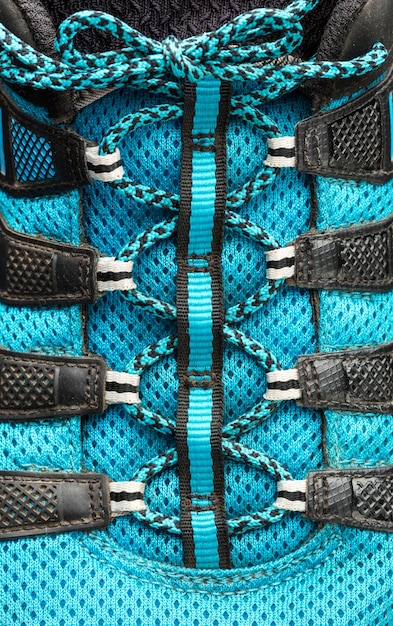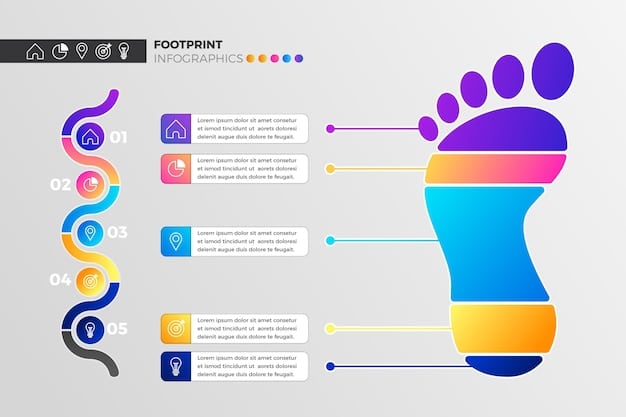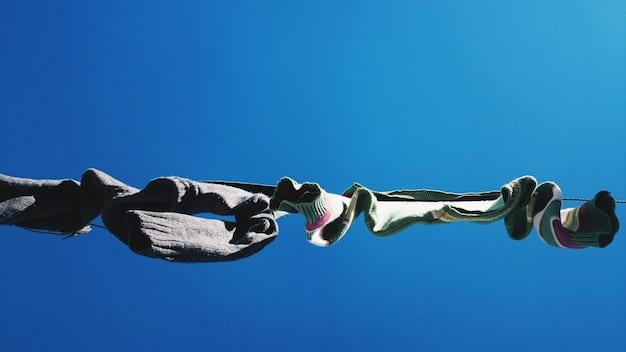Decode Shoe Lacing: Improve Comfort and Performance

Advertisements
Decoding shoe lacing techniques can lead to a 20% improvement in comfort and performance by optimizing fit, reducing pressure points, and enhancing stability, ultimately making your footwear work better for you.
Are your shoes uncomfortable, causing blisters, or impacting your performance? The secret might lie in how you lace them. Decoding shoe lacing techniques can improve your comfort and overall performance by up to 20%, it is about understanding how different lacing methods affect the fit and feel of your shoes.
Advertisements
Decoding Shoe Lacing Techniques: A Path to Enhanced Comfort
Shoe lacing is more than just tying knots; it’s an art and a science. Different lacing techniques can alleviate pressure points, provide better ankle support, and even prevent your toes from hitting the front of your shoes. By decoding shoe lacing techniques, you can greatly enhance comfort.
Why Proper Lacing Matters
Proper shoe lacing techniques can enhance comfort and performance by preventing slippage and creating a customized fit. A good lacing method can support your foot, minimizing discomfort during any activity.
Advertisements
Common Lacing Mistakes to Avoid
Many people have unconsciously adopted bad lacing habits. Overtightening, skipping eyelets, or using the wrong knot can decrease comfort and increase the risk of injury. Being aware of these common errors is the first step to enhancing your shoe lacing skills.
- Skipping Eyelets: Not using all available eyelets can lead to a loose fit, reducing support.
- Overtightening: Restricting circulation can cause discomfort and numbness.
- Using the Wrong Knot: A knot that easily comes undone can lead to accidents and decreased performance.

Understanding proper lacing is vital to ensuring that your shoes enhance your actions rather than serving as a restriction. Every detail, including the choice of knot and the placement of the laces, contributes to the entire feel and performance. By mastering the craft of lacing, you are able to unlock your shoes’ full potential.
Lacing Methods for Different Foot Issues
Not all feet are alike, and neither are their issues. Some faces deal with wide feet, while others have heel slippage. Whatever the problem, there’s a lacing technique to solve it. The proper lacing can result in a 20% Improvement on comfort and performance.
Wide Feet: Parallel Lacing
Parallel lacing creates more space in the shoe, relieving pressure on wide feet. This approach involves running the lace straight up each side, rather than crisscrossing, making the shoe feel more flexible.
Heel Slippage: Surgeon’s Knot
The surgeon’s knot, also known as a heel lock, is a must-have for people who have heel slippage. It anchors the heel in place, preventing it from moving around inside the shoe. These improvements increase performance.
- Start with standard crisscross lacing.
- At the preferred eyelets, produce a surgeon’s knot.
- Continue lacing up to the very best eyelets and tie as you normally would.
High Instep: Bar Lacing
Bar lacing offers extra room across the instep, decreasing pressure and improving comfort. This technique involves running the lace horizontally between eyelets, creating a clean, uniform appearance.
Picking the right lacing pattern can transform your experience with the shoe, changing it from a supply of soreness to a source of assistance and luxury. By addressing issues such as heel slippage, wide feet, and high insteps, you can personalize your fit and get the most out of your shoes.
Optimizing Lacing for Specific Activities
Different activities require distinctive lacing strategies. Running demands a securely equipped shoe that prevents slippage, while hiking will benefit from lacing that offers greater ankle help. Optimizing your lacing can contribute to a 20% improvement in athletic performance.

Running: Midfoot Lockdown
For running use midfoot lockdown to ensure your foot stays in place, preventing blisters and improving efficiency. This technique involves tightening the laces most tightly in the midfoot, supporting the arch, and keeping your foot from moving around.
Hiking: Ankle Support
Ankle support is crucial for hiking on uneven terrain. Use lacing techniques that provide additional support around the ankle, lowering the risk of sprains. Start with a crisscross pattern, but on the ankle vicinity create a heel lock that provides stability.
Team Sports: Secure Fit
For team sports, a secure fit is crucial for swift movements and preventing injuries. Employ a lacing technique that keeps the shoe snugly on your foot, boosting stability and responsiveness. Using parallel lacing and heel lock, you can have a secure fit.
By tailoring your lacing method on your precise activity, you can optimize both performance and luxury, making sure your shoes are working with you, no matter the task.
Materials and Knots: Enhancing Lacing Performance
The laces themselves and the knots you tie can significantly affect your shoes’ fit and performance. When choosing the right components and strategies, you could see about a 20% increase.
Choosing the Right Laces
Laces come in diverse materials, each presenting their very own blessings. Flat laces generally tend to live tied higher, while round laces can offer a smoother experience. Consider the fabric and texture when selecting laces to supplement your lacing method.
Knot Selection
The knot you pick can decide whether your laces live tied during disturbing activities. Simple knots may additionally come undone without difficulty, while greater safe knots provide brought peace of thoughts.
- Surgeon’s Knot: Very comfortable for maintaining laces tied at some stage in severe actions.
- Reef Knot: A simple and dependable knot for everyday use.
- Double Slip Knot: Provides an extra cosy grip when needed.
Choosing the right materials and knots ensures that your lacing isn’t most effective effective but also reliable. Whether you prioritize durability, comfort, or security, the right combination of laces and knots can significantly improve your shoe experience.
Troubleshooting Common Shoe Lacing Problems
Even with the right techniques, you may encounter troubles like laces that come undone or shoes that sense too tight. Troubleshooting these problems includes nice-tuning your lacing approach and making minor adjustments to optimize comfort and performance. A solution to these problems will increase comfort by 20%.
Laces Coming Undone
If your laces regularly come undone, attempt switching to a greater comfortable knot or the usage of laces manufactured from a more textured material. Additionally, make certain the laces are adequately tightened before tying them.
Shoes Feeling Too Tight
If your footwear feels too tight, attempt loosening the laces in unique areas or the use of a lacing approach that gives extra room. Parallel lacing can be specifically useful for those with wide feet.
By addressing these common lacing problems, you can ensure that your shoes provide maximum comfort and support, getting rid of distractions and allowing you to focus on your activities.
Advanced Lacing Techniques for Peak Performance
For individuals trying to take their shoe lacing to the next level, there are plenty of advanced techniques that could optimize help and responsiveness. Mastering these techniques can lead to a 20% improvement in athletic overall performance.
Window Lacing
Window lacing includes skipping positive eyelets to relieve pressure on specific areas of the foot. This is particularly beneficial for folks with bunions or other sensitive spots.
Asymmetrical Lacing
Asymmetrical lacing entails lacing the left and right sides of the shoe differently to accommodate variations in foot form. This technique can provide a personalized fit for enhanced comfort and performance.
- Assess individual foot needs.
- Adjust lacing patterns to deal with precise issues.
- Monitor comfort and overall performance to first-class-music the approach.
By experimenting with these advanced lacing techniques, you could unlock the full potential of your shoes and achieve peak overall performance. Whether you are an athlete or a fitness enthusiast, these techniques can provide a competitive edge and assist you to live comfortable during any interest.
| Key Takeaway | Brief Description |
|---|---|
| 👟 Lacing Impact | Proper lacing boosts comfort & performance significantly. |
| 🦶 Foot Issues | Techniques like parallel lacing help with wide feet. |
| 🏃 Activity Based | Midfoot lockdown suits runners; ankle support for hikers. |
FAQ Section
Proper shoe lacing ensures a snug fit, reducing friction and pressure points that cause discomfort, blisters, or foot pain. Different lacing patterns can alleviate specific foot issues and maximize comfort.
Yes, specialized lacing patterns can provide better ankle support, midfoot lockdown, and overall stability, which can enhance performance during running, hiking, team sports, cycling, and other physical activities. It’s essential for overall stability and preventing injuries.
Avoid overtightening the laces; skipping eyelets, and using inappropriate knots, which can cause discomfort, restrict circulation, and reduce support. Ensure your laces stay tied and provide a secure fit without causing undue pressure.
Parallel lacing is often recommended for wide feet, as it creates more space within the shoe, reducing pressure across the wider part of the foot. It’s also a good choice for other foot problems such as bunions.
Use the surgeon’s knot (heel lock) at the ankle to secure the heel in place. This technique involves creating a loop and tightening the laces to prevent your heel from lifting out of the shoe. Adjust tightness using a mirror to monitor.
Conclusion
In conclusion, mastering shoe lacing techniques is a simple yet effective way to improve comfort, performance, and overall foot health. By understanding the basic principles, selecting the right lacing method on your precise needs, and experimenting with advanced techniques, you can unlock the full potential of your shoes. These methods allow for a 20% improvement.